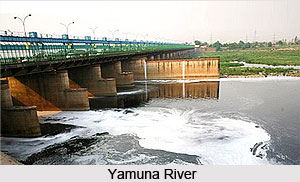 The geology of Yamuna River is known from the silt deposits it have all through the riverbed. The sediments that are collected from Delhi and Agra urban centres were examined for concentration and distribution of nine heavy metals by means of atomic adsorption spectrometry.
The geology of Yamuna River is known from the silt deposits it have all through the riverbed. The sediments that are collected from Delhi and Agra urban centres were examined for concentration and distribution of nine heavy metals by means of atomic adsorption spectrometry.
Total metal contents are different in the geological composition of the riverbed.
The ranges of the varied metal composition found in the riverbed are as follows
• Cr (157-817 mg/kg )
• Mn (515-1015 mg/kg)
• Fe (28,700-45,300 mg/kg)
• Co(11.7-28.4 mg/kg)
• Ni (40-538 mg/kg)
• Cu (40-1204 mg/kg)
• Zn (107-1974 mg/kg)
• Pb (22-856 mg/kg)
• Cd (0.50-114.8 mg/kg)
The degree of metal enrichment was compared with the standard shale concentration and shows exceptionally high values for Cr, Ni, Cu, Zn, Pb and Cd in the urban centres. In the total heavy metal concentration, anthropogenic input contains 70% Cr, 74% Cu, 59% Zn, 46% Pb, 90% Cd in Delhi and 61% Cr, 23% Ni, 71% Cu, 72% Zn, 63% Pb, 94% Cd in Agra.
A noteworthy relationship was observed between rising Cr, Ni, Zn, and Cu concentrations with increasing total sediment carbon and total sediment sulfur content. The Müller`s geoaccumulation index mentioned that the quality of the river sediments could be regarded as being moderately polluted to very highly polluted with Cr, Ni, Cu, Zn, Pb and Cd in the particular urban centres like Delhi and Agra. The present sediment analysis, therefore, plays an important role in environmental actions for the Yamuna River and the planning of these city centres.
This article is a stub. You can enrich by adding more information to it. Send your Write Up to content@indianetzone.com















